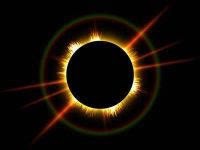Australia sees the last total solar eclipse of 2012
Photo
The Moon is seen passing in front of the Sun during a solar eclipse in Auckland, New Zealand.

A total solar eclipse was observed on Tuesday (13th) from 17:40 (GMT) in the state of Queensland, Australia. Clouds hampered the show, but even so, it was possible to observe the Sun completely covered by the Moon for a few minutes.
The eclipse could be seen from the Garig Gunak Barlu National Park, 250 kilometers east of Darwin (Northern Australia) and shifted to the east by the Gulf of Carpentaria. It is estimated that there were about 60 thousand people, among them scientists and tourists from all parts of the world in the Australian state of Queensland to witness the first total eclipse of the Great Barrier Reef in over 1300 years.
A total solar eclipse occurs when the Moon completely covers the Sun, causing the day to become night for a few minutes. The phenomenon is different from the annular solar eclipse, like the one that happened in May this year that could be seen in several cities worldwide. "In it, the moon is farthest from the Earth and is smaller than the Sun. The Moon does not cover all of the Sun, leaving something called the ring of fire," said John Paul Delicatto, iG, director of the São Paulo Planetarium.
John Paul Delicatto says the next total solar eclipse will occur in 2019.
On Tuesday, the sun was completely hidden by the Moon, reduced to a black disc with a golden halo: its outer atmosphere, which extends for several million miles. The stars also could be seen in broad daylight.
Hotels in the region were reserved for more than three years, and tourists came to fill beaches to watch the eclipse. There was even a marathon scheduled. In addition to the astronomers, other scientists also observed the eclipse. They wanted to follow, for example, how animals respond to sudden darkness, with an underwater camera on the Great Barrier Reef.
The inhabitants of Papua New Guinea, the eastern end of Indonesia, the southern half of Australia and throughout New Zealand enjoyed a partial eclipse. Polynesia, southern Chile and Argentina, also were able to appreciate the phenomenon in a partial way.
After a journey of 14,500 kilometers across the Southern Hemisphere, the eclipse ended at 23H48 GMT (21H48 GMT), about 800 miles west of Chile.
The total eclipses of the Sun have different meanings to different cultures. The daylight fades in the middle of the day and the Moon covers the sun slowly, creating a dusk, so a shadow is cast on the surface of the Earth.
Ancestral peoples of various cultures believed that the eclipse would bring bad omens. A host of rituals were made to scare evil forces that would have devoured the Sun. Today, scientists travel the world to study this rare phenomenon and thousands of people are happy just to see this celestial event of nature.
Translated from the Portuguese version by:
Lisa Karpova
Pravda.Ru
Subscribe to Pravda.Ru Telegram channel, Facebook, RSS!

